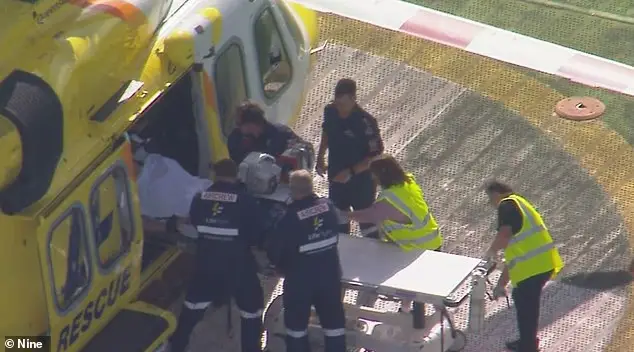Severe Lion Attack at Queensland Zoo Results in Woman’s Arm Amputation During Viewing Activity
A serious wildlife incident at Darling Downs Zoo near Toowoomba, Queensland, has resulted in a woman sustaining life-altering injuries after being attacked by a lion during what appeared to be a routine viewing activity. The incident, which occurred on Sunday morning around 8:20 AM, has prompted a comprehensive investigation by police and Workplace Health and Safety officials while raising important questions about safety protocols at wildlife facilities that offer close encounters with dangerous animals.
The victim, a woman in her 50s, suffered what authorities describe as a “significant arm injury” that ultimately resulted in the loss of her limb. She was immediately airlifted to Brisbane’s Princess Alexandra Hospital, where she remained in stable condition while undergoing emergency surgical procedures. The severity of the injury and the need for specialized trauma care necessitated the helicopter transport from the regional zoo to the metropolitan medical facility, highlighting the critical nature of her condition.
Incident Details and Immediate Response
According to statements released by Darling Downs Zoo management, the attack occurred while the woman was observing zookeepers working within the carnivore precinct of the facility. Zoo officials emphasized that the victim was not an employee, immediate family member, or keeper, but rather someone who had been granted access to observe the daily operations involving the facility’s big cats.
The zoo’s statement indicated that this type of viewing activity was not unusual for the victim, noting that “this is something that she has done many, many times over the past 20 years.” This suggests a long-standing relationship between the woman and the zoo, possibly as a volunteer, researcher, or someone with special access privileges that allowed her to observe keeper activities in restricted areas.
Zoo management described the victim as “well versed in safety protocols around potentially dangerous animals,” which makes the incident particularly concerning given her apparent experience and knowledge of proper procedures around large predators. The statement characterized the attack as inexplicable, stating that “one animal grabbed her by one arm and caused severe damage to it.”
Critically, zoo officials confirmed that the lion never left its enclosure during the incident, indicating that the attack occurred through the barrier system rather than as a result of an escape or containment failure. This detail is significant for understanding both the nature of the incident and the ongoing safety of other visitors and staff members.
Zoo Operations and Big Cat Programs
Darling Downs Zoo, located in the regional Queensland area west of Brisbane, operates as a privately-owned facility specializing in big cat conservation and education. The zoo was established by managing director Steve Robinson and his wife Stephanie, who have extensive experience in African lion management spanning nearly five decades.
The facility’s history with big cats began in 1997 when the Robinson family started breeding lions, eventually expanding their operation and relocating to the current Darling Downs location in 2002. The zoo has developed a reputation for its collection of both tawny lions and rare white lions, along with various other big cat species including Sumatran tigers, cheetahs, and leopards.
One of the zoo’s notable features is its close encounter program, which allows visitors to pay $150 for supervised experiences with lions, tigers, and leopards. These encounters involve specially trained keepers accompanying guests behind the scenes to feed the big cats using specialized equipment such as long-handled tongs. The zoo markets these experiences as providing “the thrill of a lifetime” while emphasizing safety protocols and professional supervision.
Recent social media posts from the zoo had highlighted the social nature of their lionesses, noting that they “enjoyed the company of humans immensely.” The facility regularly conducted supervised displays at 10 AM daily and offered what they termed “personalised encounters” that were described as “strictly monitored to ensure their enjoyment of them and their wellbeing.”
Safety Protocols and Industry Standards
The incident raises important questions about safety protocols at facilities that offer close encounters with dangerous wildlife. While details about the specific circumstances of the attack remain under investigation, the fact that an experienced observer was injured despite being “well versed in safety protocols” suggests either a failure of existing safety measures or an unprecedented behavioral incident.
Wildlife facilities that house large predators typically implement multiple layers of safety measures including physical barriers, specialized training for staff and authorized personnel, emergency response protocols, and strict guidelines for public access to restricted areas. The effectiveness of these measures depends on proper implementation, regular maintenance, and adherence to established procedures by all individuals with access to dangerous animals.
The zoo industry has established comprehensive guidelines for the safe management of large carnivores, including requirements for enclosure design, barrier specifications, staff training, and visitor safety protocols. These standards are developed based on decades of experience managing dangerous wildlife in captivity and are regularly updated as new information becomes available about animal behavior and safety technologies.
Investigation and Regulatory Response
Following the incident, both Queensland Police and Workplace Health and Safety personnel responded to the scene to conduct a comprehensive investigation. This multi-agency approach reflects the serious nature of the incident and the need to examine all aspects of the zoo’s operations, safety protocols, and the specific circumstances that led to the attack.
The investigation will likely examine various factors including the design and maintenance of the lion enclosure, the specific safety protocols in place for observers in the carnivore precinct, staff training and supervision procedures, and the behavior and history of the specific animal involved in the attack. Investigators will also review any surveillance footage, interview witnesses, and examine the zoo’s compliance with relevant safety regulations and industry standards.
Zoo management has indicated their full cooperation with the investigation while noting that complete details may not be available until the victim recovers sufficiently to provide her account of the incident. This cooperation is essential for understanding what occurred and implementing any necessary changes to prevent similar incidents in the future.
Animal Welfare Considerations
In their official statement, zoo management confirmed that the lion involved in the attack would not be euthanized or punished in any way. This decision reflects modern understanding of animal behavior and the recognition that such incidents often result from circumstances rather than inherent aggression or behavioral problems in the animals.
Large predators in captivity retain their natural instincts and capabilities, and interactions with humans always carry inherent risks regardless of safety measures. The decision not to punish the animal acknowledges that the lion was likely acting according to its natural behavioral patterns rather than displaying abnormal aggression that would necessitate intervention.
This approach aligns with contemporary wildlife management practices that prioritize understanding and preventing dangerous situations rather than punishing animals for behaving according to their nature. The focus remains on examining human factors, facility design, and procedural elements that may have contributed to the incident.
Industry Impact and Future Considerations
The incident at Darling Downs Zoo occurs within a broader context of ongoing discussions about the appropriate balance between wildlife education, conservation goals, and public safety at zoological facilities. While close encounter programs can provide valuable educational experiences and generate revenue for conservation efforts, they also introduce additional safety considerations that must be carefully managed.
The zoo industry continues to evolve its approaches to visitor experiences, incorporating new technologies, improved barrier designs, and enhanced training programs to minimize risks while maintaining educational value. Incidents like this often prompt industry-wide reviews of safety protocols and may lead to updated guidelines or regulatory requirements.
Educational institutions and regulatory bodies regularly examine safety incidents at wildlife facilities to identify trends, develop improved safety measures, and share best practices across the industry. The findings from the Darling Downs investigation will likely contribute to this ongoing effort to enhance safety while preserving the educational and conservation benefits of responsible wildlife facilities.
Recovery and Reopening
The zoo announced plans to reopen on Monday following the Sunday closure necessitated by the incident and subsequent investigation. This decision suggests that investigators determined there was no ongoing safety threat to visitors or staff, though the investigation into the specific circumstances continues.
The victim’s recovery process will likely be lengthy, involving not only physical rehabilitation following the amputation but also potential psychological support to address the trauma of the attack. The severity of her injuries represents a life-changing event that will require comprehensive medical care and adaptation to permanent physical changes.
Conclusion
The lion attack at Darling Downs Zoo represents a serious incident that highlights both the inherent risks associated with managing dangerous wildlife and the importance of robust safety protocols at zoological facilities. While such incidents are relatively rare, they serve as important reminders of the need for constant vigilance, continuous improvement of safety measures, and careful balance between educational opportunities and visitor protection.
As investigations continue and more details emerge about the specific circumstances of the attack, the incident will likely contribute to ongoing efforts to enhance safety standards across the wildlife facility industry. The victim’s recovery remains the immediate priority, while lessons learned from this incident may help prevent similar occurrences at other facilities managing large predators.
The situation underscores the complex challenges faced by modern zoos in fulfilling their educational and conservation missions while ensuring the safety of all individuals who interact with potentially dangerous wildlife in captivity.

Adrian Hawthorne is a celebrated author and dedicated archivist who finds inspiration in the hidden stories of the past. Educated at Oxford, he now works at the National Archives, where preserving history fuels his evocative writing. Balancing archival precision with creative storytelling, Adrian founded the Hawthorne Institute of Literary Arts to mentor emerging writers and honor the timeless art of narrative.
